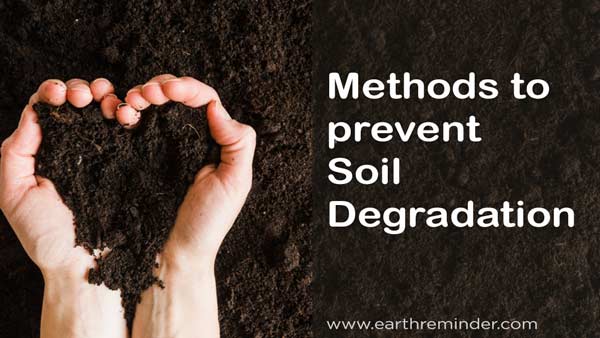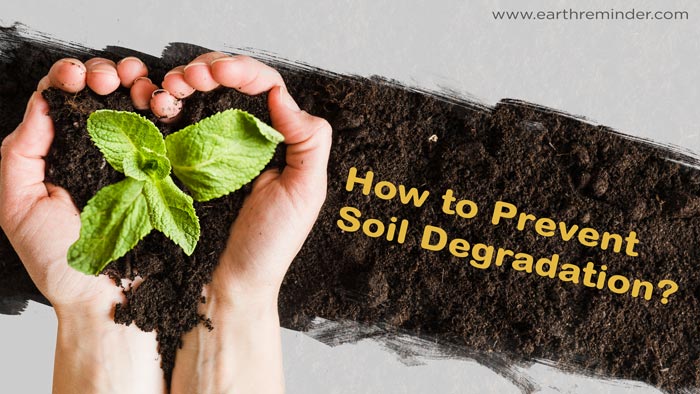How to Prevent Soil Degradation?
Soil degradation is basically the reduction and degradation of soil status. It is a condition caused by its improper use or poor management. In other words, soil degradation is a change in soil status. Soil degradation is a result of our dependency on the ecosystem in order to provide services and goods to all of its beneficiaries.
This is one of the primary environmental issues that we are debating since the 20th century and this problem is going to make us think more critically in the next centuries if it remains unsolved.
Table of Contents
Understanding Consequences of Soil Degradation
A decline in water quality: The rise in the turbidity of water and the addition of nitrogen and phosphorus can result in eutrophication.
Not only this problem but the topsoil particles lose their fertility by the poor agricultural practices and pollutants released from the industries, urban areas, etc.
Natural disasters: Natural disasters like floods, cyclones, tornadoes, and different kinds of storms several lives remain in danger. However, this further causes us to lose our most fertile soil.
Biological diversity: This may involve disorder of microbial communities, the removal of the climax vegetation and reduction in animal habitat. It is, therefore leading to biodiversity destruction and animal extinction.
Economic loss: The predicted costs for land degradation are around $40-$45 billion per year. Instead of direct estimation, further, we lose our economy by losing money over large quantities of fertilizers and pesticides for improving soil conditions, biodiversity loss and also renovating the destroyed attractive landscapes.
Impact on yield: The soil condition has a massive effect on the yield we get every year. On the other hand, the opposite, i.e., the reason for soil infertility is – large quantities of food production every year. From an estimation, it is known that about 38% of the earth’s soil is utilized for the production of food and livestock for feeding our growing population.
Methods to Prevent Soil Degradation

Windbreaks
A windbreak is a method(shelter-belt) or technique of planting of trees or shrubs, usually made up of one or more rows in such a manner as to provide shelter from the wind and to protect soil from degradation and erosion. This increase in crop yields and protects livestock from heat and cold and prevents soil degradation.
Land Reclamation
There are irreversible outcomes we get from soil quality destruction and soil degradation. However, soil quality can be improved by reversing its nutrients and organic matters. Land reclamation includes activities focused on restoring the former organic matter and soil’s essential minerals.
Land reclamation comprises several activities like blending soil with plant residues to the degraded resource and further enhancing range management. Another way of improving soil properties is by increasing vegetation, including trees, crops, and other shrubs over the degraded soil. Plants are known best for holding the soil tightly and preventing the upper soil from degrading.
Terrace Farming
Have you heard of a technique used for yielding of crops and other vegetation over the hills and mountain slopes? Well, terrace farming is precisely that. In this method, we construct terraces that are nothing but horizontal spaces. The terrace is created for long-term cultivation of different kinds of plants through accommodating a long stretch of area.
Many farmers have successfully checked soil degradation and erosion by applying this method.
Restricting salinization
“Prevention is better than cure”. This is an old proverb which advises us to take measurable steps in order to prevent the consequences. We can use this here to avoid the degradation of soil rather than trying to resolve the destruction through salinization.
Furthermore, we can protect our soil systems from gradual degradation day by day through applying some useful methods such as salt-tolerant crops planting, decelerating irrigation, and also improving facilities involved in irrigation. This is because the implantation process of soil reclamation projects demands little money and effort.
Conservation Tillage
We can describe conservation tillage as a form of tillage that reduces the number of tillage passes, where it reduces the soil aggregate separation. And at least 30% of the soil surface coated with residues, to prevent soil degradation.
Conventional tillage provides a flat and smooth surface that leaves the soil exposed to erosion. Some of the methods applied to tillage conservation include no-till planting, chiselling, strip rotary tillage and also disking assist in the protection of soil surface by leaving expanded field surface.
Decreasing Deforestation
Reforestation helps in the protection of soil. Avoiding deforestation entirely is a difficult task. But, deforestation can be cut down. However, we can get our forests back by reconstructing our most crucial natural resource. Following the rules and strictly restricting the guided areas can reduce trees to be chopped down aimlessly.
Deforestation should be controlled by several governmental measures or through various international organizations and other stakeholders of the environment as this is the most evident reason for soil quality depletion.
Striping Framing
In areas where a slope is incredibly steep, or there is no other method of preventing degradation and erosion. According to several field studies, striping farming is the most effective way of getting back soil properties which can also be described by a crop rotation system.
Contour Farming
Another method used to plant trees all around the levels of a hill instead of up and down. By this technique, we can prevent water-based soil erosion as it decreases the runoff.
Importance of Preventing and Stopping Soil Degradation
By the UN’s Food and Agriculture Organization (FAO), few essential functions of soils are:
● Soil helps to fight and adapt to climate change by gathering and saving carbon and decreasing greenhouse gas discharges (GHG) in the atmosphere.
● Flexible soils provide the facility for water infiltration through the soil, cleaning pollutants and blocking them from draining into the groundwater.
● Soil holds and reserves water for crops, whereas degraded soils hold less moisture.
● Decreasing surface evaporation and expanding water use efficiency and fertility are also processes improved by healthy soil.
● Soil contributes to fiber, fuel, medicinal products, and other ecosystem services.
● We get lots of essentials such as fibers, fuel: medicinal plants and herbs and other services related to the environment from the soil.
● Soil provides livelihood to 1/4 of biodiversity, and they are a vital part of the global cycles that make all life possible.
Conclusion
Continued soil degradation directly affects the environment and our capacity and ability to support a growing global population. At the least, it weakens the ability to utilize land optimally, and at its most dangerous, it can drive to desertification, rendering land unusable.
Controlling and reducing soil degradation is a focus of increasing awareness of the problem and promoting innovative ways in land management methods. Moreover, our climate is changing, and future weather models are frequently uncertain.
Moreover, wise and improved soil management techniques should be integrated and implemented in order to alter the soil properties that are impacted by anthropogenic and natural ways.
